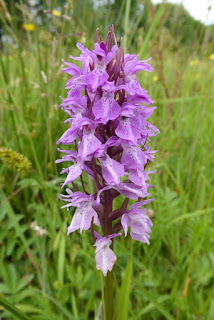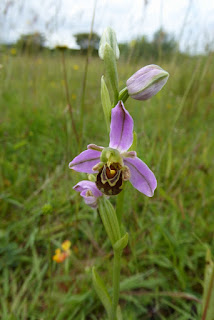Saturday June 11th and after work I headed off to Yelverton to meet Mavis and Mike for a charity butterfly walk near Walkhampton in support of Childrens Hospice South West. The charity is 25 years old this year and their fundraising theme for this year is butterflies so the walk seemed very apt.
As I left work the sun was beginning to appear from behind the clouds and it was warm and humid so I kept my fingers crossed for some interesting insect sightings including the headliner for the walk, marsh fritillaries.
The walk had been arranged by some friends of Mavis and Mike who farm near Walkhampton and where some habitat is specifically managed for marsh fritillaries with the assistance of Butterfly Conservation and Government grants. The farm was beautiful with a gorgeous garden and Linda and Barry were wonderful hosts who had put in a lot of time and effort along with various volunteers to put on an excellent walk and afternoon tea in aid of Childrens Hospice South west.
Two tractors pulling trailers headed off from the farm up onto the Moor to the first site where marsh fritllaries have been seen but as the trailers were full I ended up walking to the site which involved quite a steep walk uphill. I arrived hot and out of puff but the views were stunning and I saw a smart male redstart along the way.
A lady called Jenny from Butterfly Conservation gave a short talk about marsh fritillaries and their habitat management which was very interesting - marsh fritillaries certainly are high maintenance creatures! - and on the walk down to the fritillary field I saw a nice male wheatear along with lots of fluffy cotton grass.
By now it had clouded over but it was still warm and humid and I quickly found lots of heath spotted orchids in flower which were mostly very pale coloured.
Heath Spotted Orchid
Heath Spotted Orchid
There was no sign of any butterflies but a brief call from a cuckoo, both a garden warbler and a willow warbler singing from cover and a male reed bunting flying over kept me entertained as I wandered through the boggy grass admiring the orchids and disturbing lots of small and pale micro moths of unknown species.
I eventually found a butterfly, a small heath, but it soon flew off when it was chased by what looked like a large skipper.
Small Heath
I also found a few macro moths - a silver y, a burnet companion and best of all a chimney sweeper which quickly disappeared off into the undergrowth.
Chimney Sweeper - record shot
A large red damselfly and a female keeled skimmer, a new dragonfly species for me, were also seen and as we walked off back towards the tractors for the journey to the second fritillary site I found a green hairstreak, a little worn but nice to see.
Large Red Damselfly
Green Hairstreak
One tractor took some of the group back to the farm with the second tractor heading off to the second fritillary site. Dark clouds were beginning to roll in and this time I had an uncomfortable ride on the trailer. As we walked down to the fritillary field it began to rain and by now I wasn't hopeful of seeing anything but amazingly Jenny found a marsh fritillary on a heath spotted orchid - I thought she was joking but there it was despite the rain!
Marsh Fritillary on Heath Spotted Orchid
Marsh Fritillary
Marsh Fritillary
Marsh Fritillary
Marsh Fritillary
A small frog clambouring through the tussocky grass and another female keeled skimmer were also seen before we headed back to the farm and as we began the walk back the rain stopped and the sun came out - typical!
Keeled Skimmer - female
I did have an interesting talk with Jenny about the All The Moor Butterflies project being carried out by Butterfly Conservation to encourage landowners to manage habitat for fritillaries on Dartmoor, Exmoor and Bodmin Moor which has been running for a few years now and the project that farmers Barry and Linda are a part of - farmers can often get a bad rap but Barry and Linda are doing a wonderful job of managing their farm alongside the wildlife and doing so very quietly and unassumingly. To open up their land for a charity walk is even more admiral and I hope the project gets more landowners involved for the benefit of fritillaries and ultimately other wildlife.
I enjoyed a cup of tea and a delicious piece of home made coffee and walnut cake on our return to the farm but I was unlucky in the raffle. Everybody present seemed to have had an enjoyable and informative day despite the weather and not everybody seeing the marsh fritillary and I believe around £585 was raised for Childrens Hospice South West - not a bad day all round!

















































